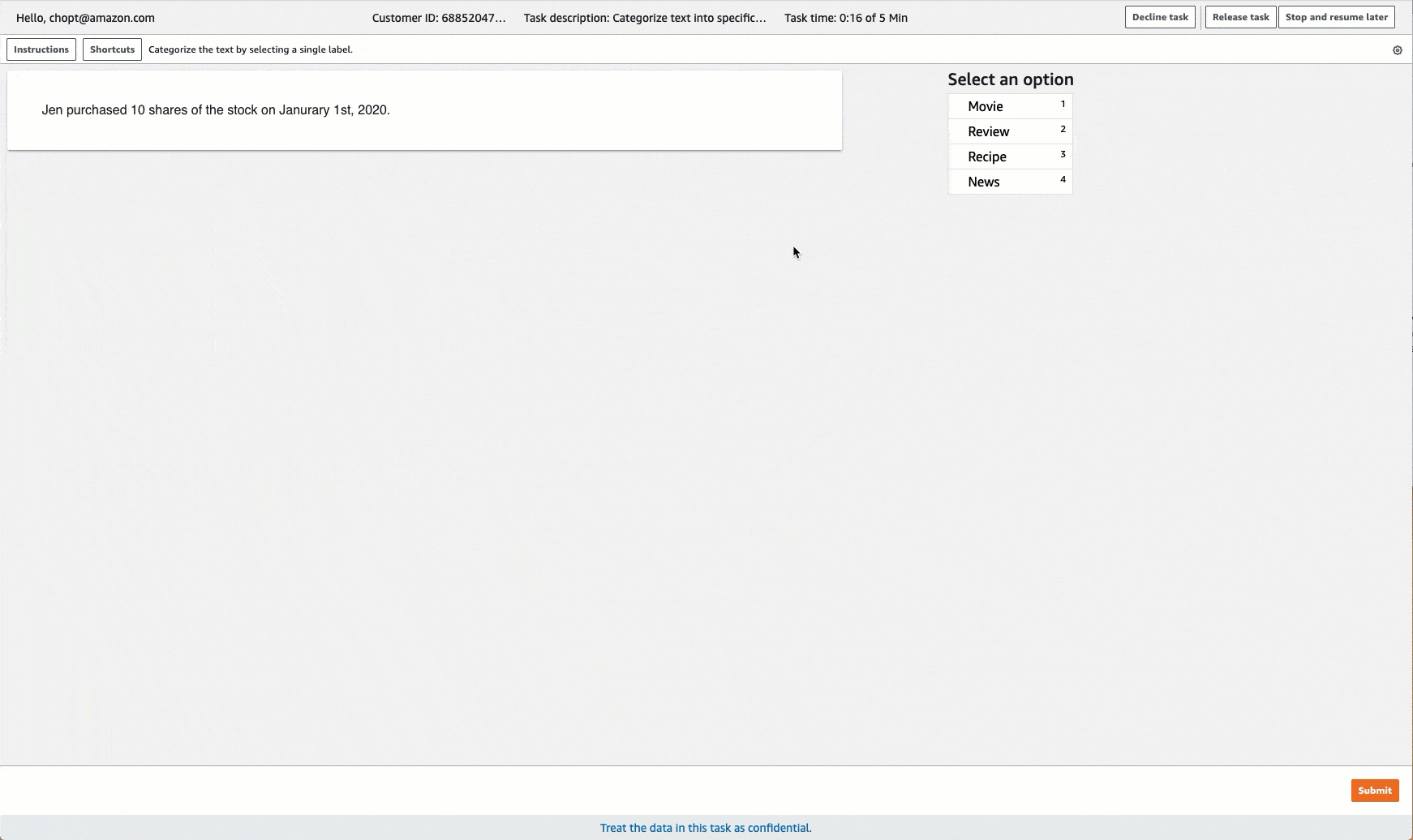Categorize text with text classification (Single Label)
To categorize articles and text into predefined categories, use text classification. For
example, you can use text classification to identify the sentiment conveyed in a review or
the emotion underlying a section of text. Use Amazon SageMaker Ground Truth text classification to have workers
sort text into categories that you define. You create a text classification labeling job
using the Ground Truth section of the Amazon SageMaker AI console or the CreateLabelingJob operation.
Important
If you manually create an input manifest file, use "source" to identify
the text that you want labeled. For more information, see Input data.
Create a Text Classification Labeling Job (Console)
You can follow the instructions Create a Labeling Job (Console) to learn how to create a text classification labeling job in the SageMaker AI console. In Step 10, choose Text from the Task category drop down menu, and choose Text Classification (Single Label) as the task type.
Ground Truth provides a worker UI similar to the following for labeling tasks. When you create the labeling job with the console, you specify instructions to help workers complete the job and labels that workers can choose from.

Create a Text Classification Labeling Job (API)
To create a text classification labeling job, use the SageMaker API operation
CreateLabelingJob. This API defines this operation for all AWS SDKs.
To see a list of language-specific SDKs supported for this operation, review the
See Also section of CreateLabelingJob.
Follow the instructions on Create a Labeling Job (API) and do the following while you configure your request:
-
Pre-annotation Lambda functions for this task type end with
PRE-TextMultiClass. To find the pre-annotation Lambda ARN for your Region, see PreHumanTaskLambdaArn . -
Annotation-consolidation Lambda functions for this task type end with
ACS-TextMultiClass. To find the annotation-consolidation Lambda ARN for your Region, see AnnotationConsolidationLambdaArn.
The following is an example of an AWS Python SDK (Boto3) request
response = client.create_labeling_job( LabelingJobName='example-text-classification-labeling-job, LabelAttributeName='label', InputConfig={ 'DataSource': { 'S3DataSource': { 'ManifestS3Uri':'s3://bucket/path/manifest-with-input-data.json'} }, 'DataAttributes': { 'ContentClassifiers': ['FreeOfPersonallyIdentifiableInformation'|'FreeOfAdultContent', ] } }, OutputConfig={ 'S3OutputPath':'s3://bucket/path/file-to-store-output-data', 'KmsKeyId':'string'}, RoleArn='arn:aws:iam::*:role/*, LabelCategoryConfigS3Uri='s3://bucket/path/label-categories.json', StoppingConditions={ 'MaxHumanLabeledObjectCount':123, 'MaxPercentageOfInputDatasetLabeled':123}, HumanTaskConfig={ 'WorkteamArn':'arn:aws:sagemaker:region:*:workteam/private-crowd/*', 'UiConfig': { 'UiTemplateS3Uri':'s3://bucket/path/worker-task-template.html'}, 'PreHumanTaskLambdaArn': 'arn:aws:lambda:us-east-1:432418664414:function:PRE-TextMultiClass, 'TaskKeywords': [Text classification', ], 'TaskTitle':Text classification task', 'TaskDescription':'Carefully read and classify this text using the categories provided.', 'NumberOfHumanWorkersPerDataObject':123, 'TaskTimeLimitInSeconds':123, 'TaskAvailabilityLifetimeInSeconds':123, 'MaxConcurrentTaskCount':123, 'AnnotationConsolidationConfig': { 'AnnotationConsolidationLambdaArn': 'arn:aws:lambda:us-east-1:432418664414:function:ACS-TextMultiClass' }, Tags=[ { 'Key':'string', 'Value':'string'}, ] )
Provide a Template for Text Classification Labeling Jobs
If you create a labeling job using the API, you must supply a worker task template
in UiTemplateS3Uri. Copy and modify the following template. Only modify
the short-instructions, full-instructions, and header.
Upload this template to S3, and provide the S3 URI for this file in
UiTemplateS3Uri.
<script src="https://assets.crowd.aws/crowd-html-elements.js"></script> <crowd-form> <crowd-classifier name="crowd-classifier" categories="{{ task.input.labels | to_json | escape }}" header="classify text" > <classification-target style="white-space: pre-wrap"> {{ task.input.taskObject }} </classification-target> <full-instructions header="Classifier instructions"> <ol><li><strong>Read</strong> the text carefully.</li> <li><strong>Read</strong> the examples to understand more about the options.</li> <li><strong>Choose</strong> the appropriate labels that best suit the text.</li></ol> </full-instructions> <short-instructions> <p>Enter description of the labels that workers have to choose from</p> <p><br></p><p><br></p><p>Add examples to help workers understand the label</p> <p><br></p><p><br></p><p><br></p><p><br></p><p><br></p> </short-instructions> </crowd-classifier> </crowd-form>
Text Classification Output Data
Once you have created a text classification labeling job, your output data will be
located in the Amazon S3 bucket specified in the S3OutputPath parameter when
using the API or in the Output dataset location field of the
Job overview section of the console.
To learn more about the output manifest file generated by Ground Truth and the file structure the Ground Truth uses to store your output data, see Labeling job output data.
To see an example of an output manifest files from a text classification labeling job, see Classification job output.